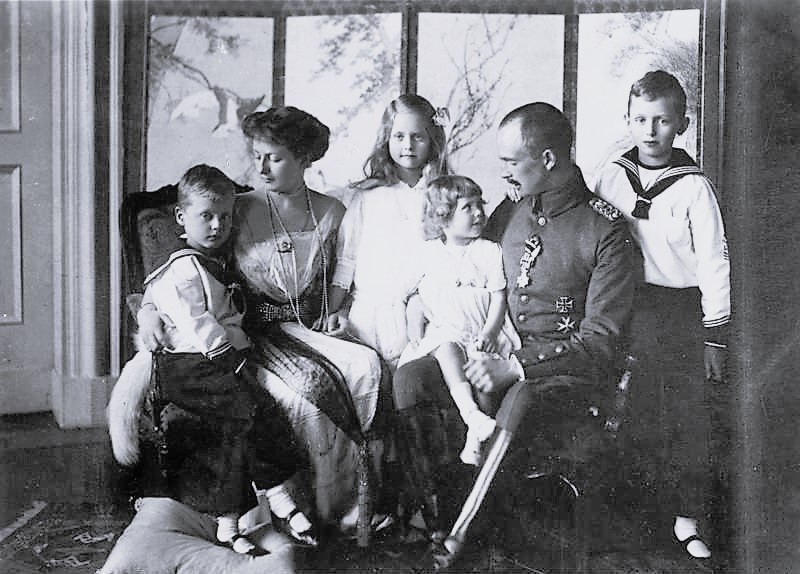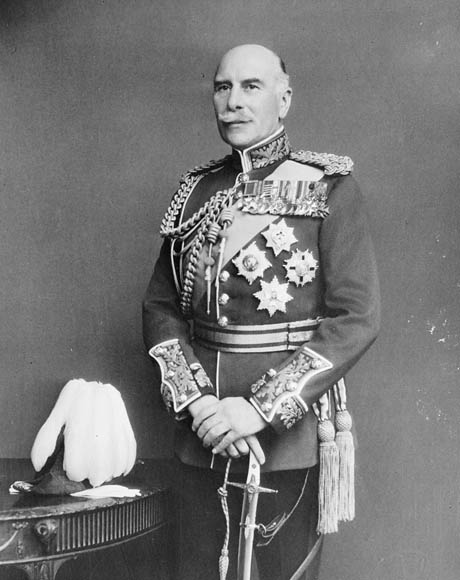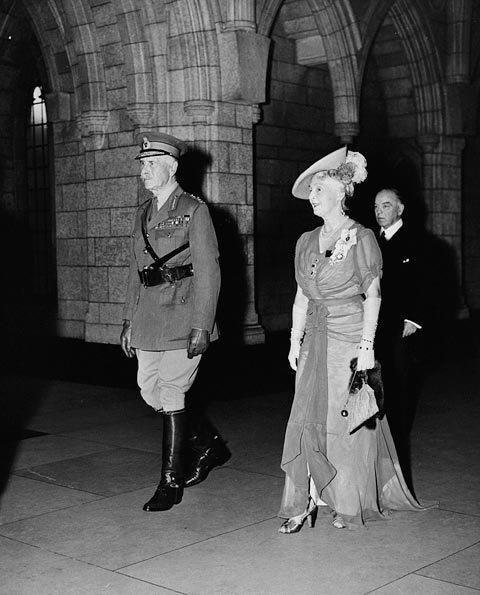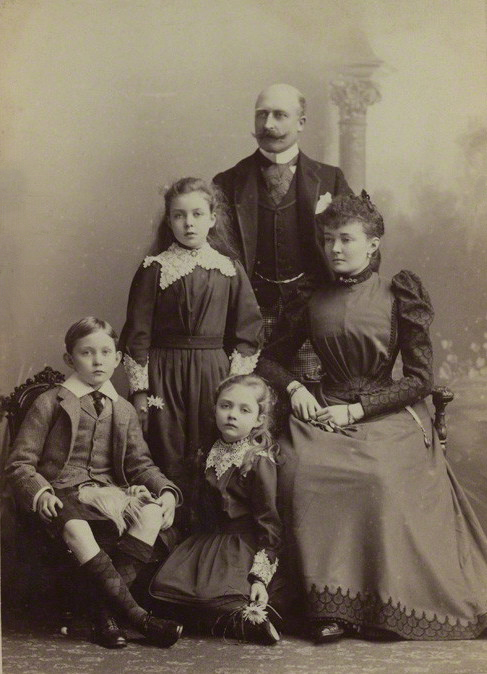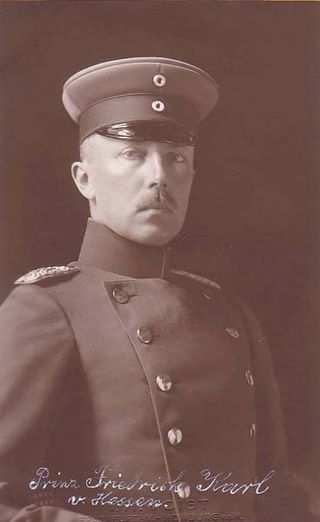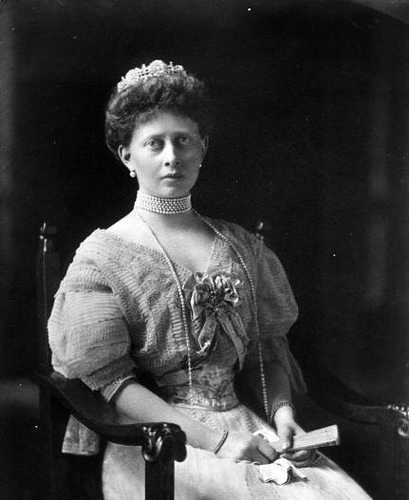by Susan Flantzer
- Captain The Honorable Julian Grenfell
- Timeline: May 1, 1915 – May 31, 1915
- A Note about German Titles
- Royals/Nobles/Peers Who Died in Action
Captain The Honorable Julian Henry Francis Grenfell

Captain The Honorable Julian Grenfell, Photo Credit – Wikipedia
Julian Grenfell is among the British poets collectively called the War Poets, soldiers writing about their war experiences. Many of them, like Julian Grenfell, died on the battlefield.
The Honorable Julian Henry Francis Grenfell was born on March 30, 1888 at 4 St. James’s Square in London, England. He was the eldest of the five children of William Henry Grenfell, 1st Baron Desborough, and Ethel Anne Priscilla Fane, daughter of the diplomat Julian Fane.
Even as a child, Julian loved to draw and write poems. He attended Eton College, where he won a prize for Latin verse, and wrote and edited for Eton magazines. After Eton, Julian attended Balliol College, Oxford, where he excelled in athletics and sports, but developed a reputation as a bully. His mother’s efforts to include him in the aristocratic social world resulted in the poem, I Won’t be Made a Social Pet! He also wrote a series of unpublished essays denouncing aristocratic society, and the feelings he had about the aristocracy may have led to his decision to join the British Army’s Royal Dragoons in 1910.
Julian first served in India and South Africa, where he wrote poems, comical plays for his fellow soldiers to perform, and articles for the regimental magazine. A poem from this time, To a Black Greyhound, expresses the closeness he felt with animals. After the outbreak of World War I, Julian served in France and Belgium where he developed a reputation for courage. In 1914, Julian was awarded the Distinguished Service Order (DSO) for his action in stalking German snipers and shooting them from close range. Julian was then offered a non-combat position as an aide-de-camp. He refused, saying his regiment was short of officers, and wrote a satirical poem, Prayer for Those on the Staff.
On May 13, 1915, Julian was wounded in the head by splinters from a bombshell while monitoring enemy troop movements during the Second Battle of Ypres in Belgium. He was taken to a hospital in Boulogne, France where he died on May 26, 1915 at the age of 27, after two failed operations, and surrounded by his parents and his sister Monica, a Red Cross nurse. Julian’s younger brother Gerald William (Billy) Grenfell was killed in action on July 30, 1915, within a mile of where Julian had been wounded.
Julian Grenfell was buried at the Boulogne Eastern Cemetery in France, and he is one of the sixteen Great War (World War I) poets commemorated on a slate stone unveiled November 11, 1985 in the South Transept (Poet’s Corner) of Westminster Abbey.
Westminster Abbey: Poets of the First World War

Grave of Julian Grenfell Photo Credit – findagrave.com
Grenfell’s best-known poem, Into Battle, was written at a time of confusion as he and his men waited to go to the front near Ypres, Belgium. The poem, often included in literature anthologies, was first published in The Times along with Grenfell’s obituary.
Into Battle by Julian Grenfell
The naked earth is warm with Spring,
And with green grass and bursting trees
Leans to the sun’s gaze glorying,
And quivers in the sunny breeze;
And life is Colour and Warmth and Light,
And a striving evermore for these;
And he is dead who will not fight,
And who dies fighting has increase.
The fighting man shall from the sun
Take warmth, and life from glowing earth;
Speed with the light-foot winds to run
And with the trees to newer birth;
And find, when fighting shall be done,
Great rest, and fulness after dearth.
All the bright company of Heaven
Hold him in their bright comradeship,
The Dog star, and the Sisters Seven,
Orion’s belt and sworded hip:
The woodland trees that stand together,
They stand to him each one a friend;
They gently speak in the windy weather;
They guide to valley and ridges end.
The kestrel hovering by day,
And the little owls that call by night,
Bid him be swift and keen as they,
As keen of ear, as swift of sight.
The blackbird sings to him: “Brother, brother,
If this be the last song you shall sing,
Sing well, for you may not sing another;
Brother, sing.”
In dreary doubtful waiting hours,
Before the brazen frenzy starts,
The horses show him nobler powers; —
O patient eyes, courageous hearts!
And when the burning moment breaks,
And all things else are out of mind,
And only joy of battle takes
Him by the throat and makes him blind,
Through joy and blindness he shall know,
Not caring much to know, that still
Nor lead nor steel shall reach him, so
That it be not the Destined Will.
The thundering line of battle stands,
And in the air Death moans and sings;
But Day shall clasp him with strong hands,
And Night shall fold him in soft wings.
*********************************************************
Timeline: May 1, 1915 – May 31, 1915
May 1: The Gorlice-Tarnów Offensive begins near Krakow, Poland
May 1: Battle of Eski Hissarlik on the Gallipoli Peninsula
May 3: Troops withdraw from Anzac Cove on the Gallipoli Peninsula
May 6 – 8: Second Battle of Krithia on the Gallipoli Peninsula
May 7: British ocean liner Lusitania is sunk by a German U-boat
May 8 – 13: Battle of Frezenberg Ridge, part of the Second Battle of Ypres in Belgium
May 9 – June 18: Second Battle of Artois in Artois, France
May 9: Battle of Aubers Ridge, a phase of the Second Battle of Artois near Armentières, France
May 10: Troops from Hungary rout the Russians at Jarosław, Poland
May 11: Armistice called at Gallipoli to bury the dead
May 12: Windhoek, capital of German South-West Africa (now Namibia), is occupied by South African troops
May 15 – 25: Battle of Festubert near Neuve Chapelle, France
May 16 – June 23: Battle of Konary near the town of Klimontów, Poland
May 23: Italy declares war on Austria-Hungary
May 24 –25: Battle of Bellewaarde, final phase of the Second Battle of Ypres in Belgium
*********************************************************
Most of the royals who died in action during World War I were German. The German Empire consisted of 27 constituent states, most of them ruled by royal families. Scroll down to German Empire here to see what constituent states made up the German Empire. The constituent states retained their own governments, but had limited sovereignty. Some had their own armies, but the military forces of the smaller ones were put under Prussian control. In wartime, armies of all the constituent states would be controlled by the Prussian Army and the combined forces were known as the Imperial German Army. German titles may be used in Royals Who Died In Action below. Refer to Unofficial Royalty: Glossary of German Noble and Royal Titles.
24 British peers were also killed in World War I and they will be included in the list of those who died in action. In addition, more than 100 sons of peers also lost their lives, and those that can be verified will also be included.
*********************************************************
May 1915 – Royals/Nobles/Peers Who Died In Action
The list is in chronological order and does contain some who would be considered noble instead of royal. The links in the last bullet for each person is that person’s genealogical information from Leo’s Genealogics Website or to The Peerage website. If a person has a Wikipedia page, their name will be linked to that page.

Arthur Reginald French, 5th Lord De Freyne
- son of Arthur French, 4th Lord De Freyne and Lady Louisa Dundas
- half-brother of George French, below
- born July 3, 1879 in London, England
- married 1902 Annabel Angus, no issue
- killed in action May 9, 1915, age 35
- http://www.genealogics.org/getperson.php?personID=I00227012&tree=LEO
Ralph Chalmers
- son of Robert Chalmers, 1st Baron Chalmers and Maud Pigott
- brother of Robert Chalmers, below
- born January 13, 1891
- unmarried
- killed in action May 8, 1915, age 24
- http://www.genealogics.org/getperson.php?personID=I00586258&tree=LEO
The Honorable George French
- son of Arthur French, 4th Lord De Freyne and Marie Lamb
- half-brother of Arthur French, above
- born January 7, 1890
- killed in action May 9, 1915, age 25
- http://www.genealogics.org/getperson.php?personID=I00227018&tree=LEO
The Honorable Keith Stewart
- son of Randolph Stewart, 11th Earl of Galloway and Amy Cliffe
- born September 8, 1894
- killed in action May 9, 1915, age 20
- http://www.genealogics.org/getperson.php?personID=I00276743&tree=LEO
The Honorable Henry Hardinge
- son of Henry Charles Hardinge, 3rd Viscount Hardinge of Lahore and Kings Newton and Mary Frances Nevill
- born October 13, 1895
- killed in action May 9, 1915, age 19
- http://thepeerage.com/p5271.htm#i52709
The Honorable Talbot Stanhope
- son of Dudley Stanhope, 9th Earl of Harrington and Kathleen Carter Wood
- born November 23, 1896
- killed in action May 9, 1915, age 18
- http://www.genealogics.org/getperson.php?personID=I00087169&tree=LEO
The Honorable William Rodney
- son of George Rodney, 7th Baron Rodney of Rodney Stoke and The Honorable Corisande Vere Guest
- born October 2, 1896
- killed in action May 9, 1915, age 18
- http://www.genealogics.org/getperson.php?personID=I00465002&tree=LEO
The Honorable Percy Evans-Freke
- son of William Evans-Freke, 8th Baron Carbery and Lady Victoria Cecil
- born May 19, 1871
- married 1895 Eva Kirwan, had issue
- killed in action May 13, 1915, age 43
- http://www.genealogics.org/getperson.php?personID=I00188629&tree=LEO
Lord Spencer Compton
- son of William Compton, 5th Marquess of Northampton and The Honorable Mary Baring
- born May 3, 1893
- killed in action May 13, 1915, age 22
- http://www.genealogics.org/getperson.php?personID=I00221840&tree=LEO
The Honorable Clement Freeman-Mitford
- son of Algernon Freeman-Mitford, 1st Baron Redesdale and Lady Clementina Ogilvy
- brother of the Mitford sisters, Jessica, Nancy, Diana, Unity and Pamela
- born December 14, 1876
- married, had issue
- killed in action May 13, 1915, age 38
- http://www.genealogics.org/getperson.php?personID=I00224859&tree=LEO
Colwyn Philipps
- son of John Wynford Philipps, 1st Viscount St. Davids and Nora Gerstenberg
- born December 11, 1888
- killed in action May 13, 1915, age 26
- http://thepeerage.com/p3302.htm#i33019
John Bigge
- son of Arthur Bigge, 1st Baron Stamfordham, Private Secretary to Queen Victoria and King George V, and Constance Neville
- born October 14, 1887
- killed in action in France on May 15, 1915, age 27
- http://thepeerage.com/p47039.htm#i470385
The Honorable Alexander Hepburne-Scott
- son of Walter Hepburne-Scott, 9th Lord Polwarth and Edith Buxton
- born October 14, 1892
- killed in action May 16, 1915, age 22
- http://thepeerage.com/p55192.htm#i551918
The Honorable William Order-Powlett
- son of Lt.-Col. William Orde-Powlett, 5th Baron Bolton of Bolton Castle and The Honorable Elizabeth Gibson
- born on April 7, 1894
- killed in action May 17, 1915, age 21
- http://thepeerage.com/p13795.htm#i137941
Robert Howard
- son of Robert Howard and Margaret Smith, 2nd Baroness Strathcona and Mount Royal
- born 1893
- killed in May 18, 1915, age 22
- http://www.thepeerage.com/p58620.htm#i586193
The Honorable Arthur Coke
- son of Thomas Coke, 3rd Earl of Leicester of Holkham and The Honorable Alice White
- born April 6, 1882
- married, had issue
- killed in action Dardanelles May 22, 1915, age 33
- http://www.genealogics.org/getperson.php?personID=I00493589&tree=LEO
The Honorable Julian Grenfell (see article above)
- son of William Grenfell, 1st Baron Desborough and Ethel Fane
- born March 30, 1888 in London, England
- died from battle wounds May 26, 1915, age 27
- http://www.genealogics.org/getperson.php?personID=I00135100&tree=LEO
Robert Chalmers
- son of Robert Chalmers, 1st Baron Chalmers and Maud Pigott
- brother of Ralph Chalmers, above
- born April 13, 1894
- died of battle wounds on May 26, 1915, age 21
- http://www.genealogics.org/getperson.php?personID=I00586259&tree=LEO
The Honorable Cormac Deane-Morgan
- son of Hamilton Deane-Morgan, 4th Baron Muskerry and Flora Skeffington
- born 1892
- killed when HMS Princess Irene exploded on May 27, 1915, age 23
- http://thepeerage.com/p31675.htm#i316750
Count Peter Alexandrovich Benckendorff
- son of Count Alexander Konstantinovich Benckendorff, Russian ambassador to Denmark and the United Kingdom, and Countess Sophie Petrovna Schouvaloff
- born January 13, 1882 in St. Petersburg, Russia
- married 1909 Elena Dmitrievna Naryshkina
- killed in action May 27, 1915, age 33
- http://www.genealogics.org/getperson.php?personID=I00244161&tree=LEO
Ernst, Freiherr von Saalfeld
- son of Prince Ernst of Saxe-Meinigen and Katharina Jensen (morganatic marriage)
- born July 4, 1896 in Florence, Italy
- killed in action at Josefovo, near Kielmy, Lithuania May 28, 1915, age 18
- http://www.thepeerage.com/p11087.htm#i110869
The Honorable William Nugent
- son of William Nugent, 10th Earl of Westmeath and Emily Blake
- born March 11, 1876
- married 1913 Kathleen Stoner
- killed in action May 29, 1915, age 39
- http://thepeerage.com/p53015.htm#i530145



